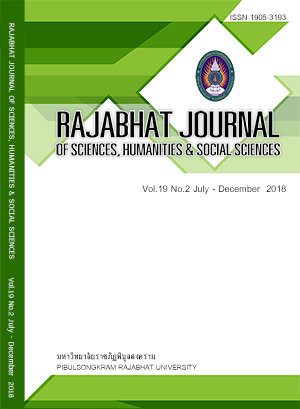CHEMICAL COMPOSITION AND ANTIBACTERIAL ACTIVITY OF ESSENTIAL OILS FROM THREE CURCUMA SPECIES IN THAILAND
Keywords:
turmeric, antibacterial activity, essential oilAbstract
The aim of this research was to analyze the chemical composition and to evaluate antibacterial activity of essential oils from three turmeric types grown in Thailand. Turmeric essential oils from rhizomes of Curcuma zedoaria, C. longa and C. aeruginosa were obtained by steam distillation. Agar well diffusion method, Broth dilution method and Agar dilution method were used to test antibacterial activities against Bacillus cereus, Escherichia coli, Pseudomonas aeruginosa, Salmonella typhimurium, Methicillin-resistant Staphylococcus aureus (MRSA), S. aureus and S. epidermidis. The chemical composition of essential oil was analyzed by Gas chromatography–mass spectroscopy (GC-MS) technique. Agar well diffusion test showed that the growth of seven bacteria was inhibited by at least 1 mg/ml of three types turmeric essential oils. The minimum inhibitory concentration (MIC) test showed that C. zedoaria essential oil provided higher activity against P. aeruginosa, MRSA and S. epidermidis than C. longa and C. aeruginosa with MIC value of 62.50 µg/ml. The minimum bactericidal concentration (MBC) of the essential oils obtained from three types of turmeric samples were not different. GC-MS analysis showed the presence of 25, 16 and 14 compounds found in the essential oils obtained from C. zedoaria, C. longa and C. aeruginosa, respectively. b-Turmerone (14.32 %), ar-turmerone (35.41 %) and camphor (9.04 %) were the major components found in the essential oils distillated from C. zedoaria, C. longa and C. aeruginosa, respectively. Therefore, the turmeric essential oils mainly contained a large number of terpenes and significantly exhibited antibacterial activity.
References
Baik KU, Jung SH, Ahn BZ. Recognition of pharmacophore of ar-turmerone for its anticancer activity, Archives of Pharmacal Research. 1993; 16: 254–256.
Berniyanti T. Mahmiyah E. Microbiological studies on the production of antimicrobial agent by saponin Aloe vera L. against Streptococcufs sanguinis, Research Journal of Microbiology. 2015; 10(8): 385-392.
Burt S. Essential oils: Their antibacterial properties and potential applications in foods: A review, International Journal of Food Microbiology. 2004; 94: 223–253.
Chen W, Vermaak I, Viljoen A. Camphor a fumigant during the black death and a coveted fragrant wood in ancient egypt and babylon a review. Molecules. 2013; 18: 5434-5454.
Hu YS, Du QY, Tang QH. Study of chemical constituents of volatile oil from Curcuma longa by GC-MS. Zhongguo Yaoxue Zazhi. 1997; 32: 35–36.
Islam MR, Ahamed R, Rahman Md. O. In vitro antimicrobial activities of four medicinally important plants in Bangladesh, Journal of Scientific Research. 39(2); 2010: 199-206.
Jankasem M, Wuthi-udomlert M, Gritsanapan W. Antidermatophytic properties of ar-turmerone, turmeric oil, and Curcuma longa preparations. ISRN Dermatol; 2013: 1-3.
Jose S, Thomas TD. Comparative phytochemical and antibacterial studies of two indigenous medicinal plants Curcuma caesia Roxb. And Curcuma aeruginosa Roxb. International Journal of Green Pharmacy. 2014; 8: 65-71.
Kamazeri TS, Samah OA, Taher M. et al. Antimicrobial activity and essential oils of Curcuma aeruginosa, Curcuma mangga, and Zingiber cassumunar from Malaysia. Asian Pacific Journal of Tropical Biomedicine. 2012; 5(3): 202-209.
Lai EY, Chyau CC, Mau JL. et al. Antimicrobial activity and cytotoxicity of the essential oil of Curcuma zedoaria. Journal of Chinese Medicine. 2004; 32(2): 281–290.
Lee HS. Antimicrobial properties of turmeric (Curcuma longa L.) rhizome-derived ar-turmerone and curcumin. Food Science and Biotechnology. 2006; 15: 559–563.
Martins AP, Salgueiro L, Goncalves MJ. et al. Essential oil composition and antimicrobial activity of three Zingiberaceae from S. Tomé e Príncipe. Planta Medica. 2001; 67: 580–584.
Mau J, Laib E, Wang N. et al. Composition and antioxidant activity of the essential oil from Curcuma zedoaria. Food Chemistry. 2003; 82: 583-591.
Negi PS, Jayaprakasha GK, Jagan Mohan Rao L. et al. Antibacterial activity of turmeric oil: by product from curcumin manufacture, Journal of Agricultural and Food Chemistry. 1999; 47: 4297-300.
Nigam MC, Ahmed A. Curcuma longa: Terpenoid composition of its essential oil. Indian Perfumer. 1991; 3: 201–205.
Pojanaukij N, Kajorncheappunngam S. Comparison of antimicrobial activity of Mangosteen crude, Turmeric and Gotu Kola extract, Naresuan University Journal. 2010; 18(1): 1-9.
Prakosa DG, Andayani S, Maftuch. In vitro phytochemical and antibacterial activity test on temuputih extract (Curcuma zedoaria) against Aeromonas hydrophila. International journal of scientific & technology research, 2016; 5(2): 36-37.
Rangsipanuratn W, Kammarnjassadakul P, Janwithayanuchit I. Antibacterial activities of ten Thai herbal extracts against staphylococcus aureus ATCC 25923, Bacillus cereus and Escherichia coli ATCC 25922, Huachiew Chalermprakiet University Journal. 2016; 19(38): 35-48.
Sharma RK, Misra BP, Sarma TC. et al. Essential oils of Curcuma longa L. from Bhutan. Journal of Essential Oil Research. 1997; 9: 589–592.
Singh P, Singh S, Kapoor IPS. et al. Chemical composition and antioxidant activities of essential oil and oleoresins from Curcuma zedoaria rhizomes, part-74, Food Bioscience. 2013; 3: 42–48.
Singh G, Singh OP, Maurya S. Chemical and biocidal investigations on essential oils of some Indian Curcuma species, Progress in Crystal Growth and Characterization. 2002; 45: 75-81.
Soković M, Marin PD, Brkć D. et al. Chemical composition and antibacterial activity of essential oils of ten aromatic plants against human pathogenic bacteria, Food. 2007; 1: 220-226.
Srisayam M. Chantawannakul P. Antimicrobial and antioxidant properties of Thai honeys produced by Apis mellifera in Thailand. Journal of ApiProduct and ApiMedical Science. 2010; 2(2): 77-83.
Usman LA, Hamid AA, George OC. et al. Chemical composition of rhizome essential oil of Curcuma longa L. growing in North Central Nigeria, World Journal of Chemistry. 2009; 4: 178-181.
Wilson B, Abraham G, Manju VS. et al. Antimicrobial activity of Curcuma zedoaria and Curcuma malabarica tubers, Journal of Ethnopharmacol. 2005; 99: 147–151.
Zhu J, Lower-Nedza AD, Hong M. et al. Chemical composition and antimicrobial activity of three essentialoils from Curcuma wenyujin, Natural Product Communications. 2013; 8: 523-526.
Zwaving JH, Bos R. Analysis of the essential oils of five Curcuma species, Flavour and Fragrance Journal. 2006; 7(1): 19-22.
Downloads
Published
How to Cite
Issue
Section
License
Each article is copyrighted © by its author(s) and is published under license from the author(s).










